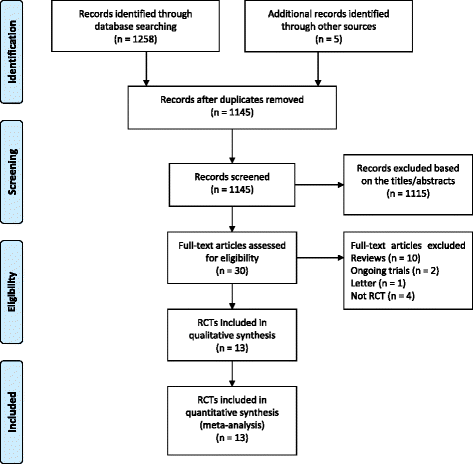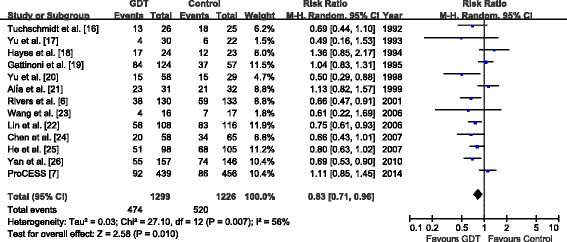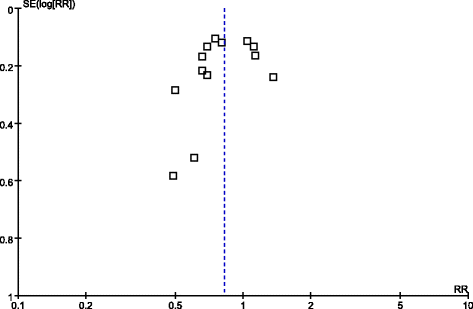The effect of goal-directed therapy on mortality in patients with sepsis - earlier is better: a meta-analysis of randomized controlled trials
- PMID: 25327977
- PMCID: PMC4232636
- DOI: 10.1186/s13054-014-0570-5
The effect of goal-directed therapy on mortality in patients with sepsis - earlier is better: a meta-analysis of randomized controlled trials
Abstract
Introduction: The Surviving Sepsis Campaign guidelines recommend goal-directed therapy (GDT) for the early resuscitation of patients with sepsis. However, the findings of the ProCESS (Protocolized Care for Early Septic Shock) trial showed no benefit from GDT for reducing mortality rates in early septic shock. We performed a meta-analysis to integrate these findings with existing literature on this topic and evaluate the effect of GDT on mortality due to sepsis.
Methods: We searched the PubMed, Embase and CENTRAL (Cochrane Central Register of Controlled Trials) databases and reference lists of extracted articles. Randomized controlled trials comparing GDT with standard therapy or usual care in patients with sepsis were included. The prespecified primary outcome was overall mortality.
Results: In total, 13 trials involving 2,525 adult patients were included. GDT significantly reduced overall mortality in the random-effects model (relative risk (RR), 0.83; 95% confidence interval (CI), 0.71 to 0.96; P =0.01; I 2 = 56%). Predefined subgroup analysis according to the timing of GDT for resuscitation suggested that a mortality benefit was seen only in the subgroup of early GDT within the first 6 hours (seven trials; RR, 0.77; 95% CI, 0.67 to 0.89; P =0.0004; I 2 = 40%), but not in the subgroup with late or unclear timing of GDT (six trials; RR, 0.92; 95% CI, 0.69 to 1.24; P =0.59; I 2 = 56%). GDT was significantly associated with the use of dobutamine (five trials; RR, 2.71; 95% CI, 1.20 to 6.10; P =0.02).
Conclusions: The results of the present meta-analysis suggest that GDT significantly reduces overall mortality in patients with sepsis, especially when initiated early. However, owing to the variable quality of the studies, strong and definitive recommendations cannot be made.
Figures





Comment in
-
Early goal-directed therapy: what do we do now?Crit Care. 2014 Dec 29;18(6):705. doi: 10.1186/s13054-014-0705-8. Crit Care. 2014. PMID: 25672439 Free PMC article.
References
-
- Dellinger RP, Levy MM, Rhodes A, Annane D, Gerlach H, Opal SM, Sevransky JE, Sprung CL, Douglas IS, Jaeschke R, Osborn TM, Nunnally ME, Townsend SR, Reinhart K, Kleinpell RM, Angus DC, Deutschman CS, Machado FR, Rubenfeld GD, Webb SA, Beale RJ, Vincent JL, Moreno R, Surviving Sepsis Campaign Guidelines Committee including the Pediatric Subgroup Surviving Sepsis Campaign: international guidelines for management of severe sepsis and septic shock: 2012. Crit Care Med. 2013;41:580–637. doi: 10.1097/CCM.0b013e31827e83af. - DOI - PubMed
-
- Centers for Disease Control and Prevention (CDC) Current trends: increase in National Hospital Discharge Survey rates for septicemia—United States, 1979–1987. MMWR Morb Mortal Wkly Rep. 1990;39:31–34. - PubMed
Publication types
MeSH terms
LinkOut - more resources
Full Text Sources
Other Literature Sources
Medical

